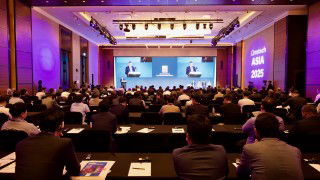Cemtech Asia 2018 was held at the Meliá Hanoi, Vietnam, on 24-27 June, and welcomed 225 delegates to participate in a conference and exhibition that celebrated the thriving cement industry of the region. By ICR Research, UK.
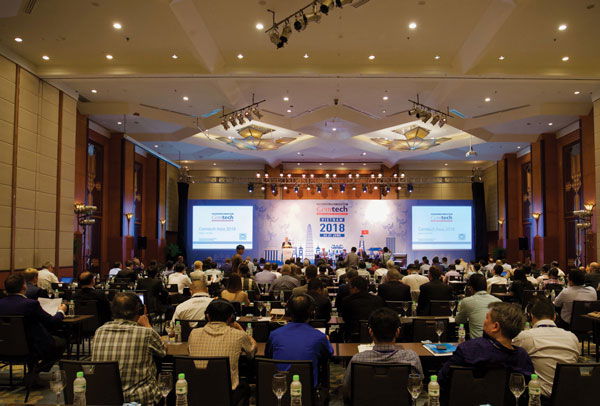
Thomas Armstrong, managing editor, ICR, welcomed delegates to Cemtech Asia 2018
Thomas Armstrong, managing editor of International Cement Review, inaugurated Cemtech Asia 2018 by welcoming the 225 conference participants and acknowledging the importance of the Asian cement sector, where 75 per cent of the world’s cement is consumed. Mr Armstrong introduced the 10 markets of the ASEAN region, which has seen its consumption double since 1997 to 220Mt in 2017. In particular, Vietnam has recorded significant growth over the past 30 years, from 2.57Mta to 60Mta in 2017.
Conference programme
Market reports
The first morning of the conference continued with a detailed overview of the Asian markets. Vietnam is one of the most active markets in the region. As a result of its rapid development phase it has a cement industry ranked amongst the top five in the world. Dr Nguyen Quang Cung, president of the Vietnam National Cement Association (VNCA), examined the current structure of the country’s cement sector and announced future investment projects, including the construction of five new clinker lines. Going forward, the government is developing a new industry strategy to raise efficiency and environmental performance for the period until 2030.
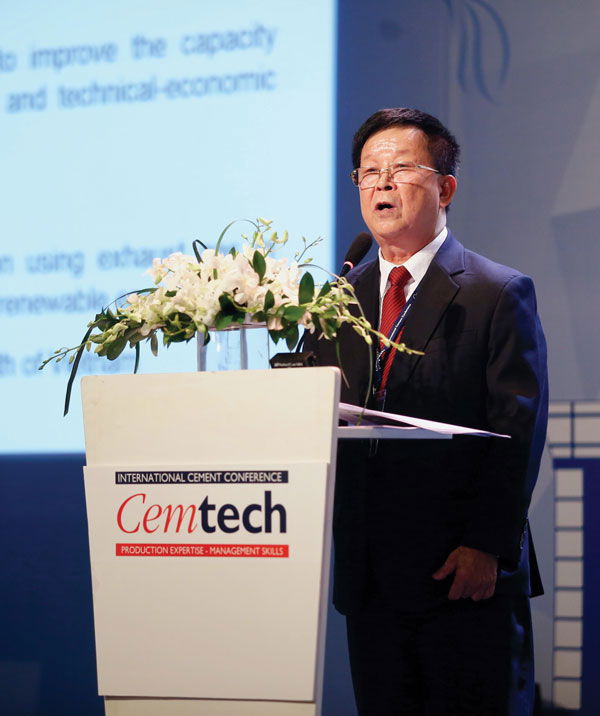
Dr Nguyen Quang Cung, VNCA, looked at the future
of the Vietnamese cement sector
Dr Tongbo Sui, China Cement Association, provided an overview of the Chinese cement industry and highlighted the importance of upgrading and adapting the sector for green manufacturing and its development as a key contributor to the circular economy. The industry aims to reduce CO2 emissions by 40-45 per cent per unit of GDP by 2020 and continue efforts to co-process municipal solid waste (MSW) and reduce NOx emissions.
Dr Yourong Chen, CNBM Group (China), followed this by showing trends for energy-saving technology in the Chinese cement industry, in line with the country’s target to reduce both NOx emissions and energy intensity per GDP by 15 per cent before 2020. Mr Chen noted several examples which increase the energy-saving characteristics of the burning system, including a six-stage suspension preheater and innovative precalciner which increases kiln capacity and prolongs the gas residence time.
Dr Shailendra Chouksey, Cement Manufacturers’ Association (India), explored how the Indian cement industry will face rising demand from government projects such as a scheme to build 10.7m homes in rural areas and 3.7m units in urban regions. Furthermore, the country’s cement sector is expected to benefit from increased investment in infrastructure, with overall growth needed to increase capacity utilisation, which is low at 59 per cent.
ICR’s Technical Consultant and founder of Whitehopleman (UK), Dr Michael Clark, presented an overview of industry developments that have taken place during the first 30 years of ICR’s publication.
Soe Naing, Myanmar Cement Association, analysed the future risk of overcapacity within Myanmar’s cement industry. The country currently operates 18 plants, two clinker grinding plants and a terminal, with a total production capacity of 7Mta. While the industry began producing surplus in 2015, several future construction projects could push demand up to 25Mta.

Shailendra Chouksey, president of the Cement
Manufacturers’Association of India, expects the
Indian cement sector to benefit from rising demand
Adi Munandir, PT Semen Indonesia (Indonesia), analysed the challenges and opportunities of the Indonesian cement industry. While it has a long-term overcapacity projection and is still in a recovery process, the country’s cement industry could face increased demand from its rapidly-growing population. Moreover, solutions could arise in the form of value-added products and an increased infrastructure spending budget.
UK-based independent consultant, Peter Hoddinott, examined ways to resolve structural overcapacity. A growing issue with an estimated 2bnta of global overcapacity and capacity additions continually outstripping demand, finding a solution for overcapacity is particularly important for the Asian region. In addition to strategies such as cutting costs, securing the domestic market and avoiding price wars, Mr Hoddinott proposed an innovative M&A solution to enable capacity rationalisation in oversupplied markets.
Stephen Farren, FLSmidth (Denmark), presented a case study of how the supplier upgraded Xuan Thanh Cement’s Ha Nam facility into having a world-class operation and maintenance (O&M) performance. The company’s O&M options include an online support centre, onsite support, technical management and a full O&M partnership.
Jim O’Brien, Jim O’Brien CSR Consulting (Ireland), looked at how sustainability can be used to boost profitability. Alternative fuels and raw materials, for example, come at a medium-level cost but can be a major profit improver.
The final two presentations of the first day explored manufacturing technology, which would become the driving focus of the following day. FCT Combustion’s Roger Hassold (Australia) explored how its Turbu-FlexTM burner features an injection pattern which increases fuel flexibility and can lower fuel costs. Luc Reiffel, ATS Group/Walter Materials Handling (France), presented a series of case studies from the ASEAN region that highlighted technologies used to allow a larger alternative fuel grainsize into the pyroprocessing system, which in turn reduces the pre-processing cost.
Technical presentations
KHD Humboldt Wedag’s Dr York Reichardt (Germany) commenced the technical presentations of the second day by observing how its roller press with stud lining can operate for 40,000h without refurbishment, whereas re-welding is usually required in a VRM after 4000h. Furthermore, he introduced the GrindX® RP7 140/80 modular plant, which is designed for simple assembly.
The topic of modular grinding stations (MGSs) continued with Cemengal’s Moisés Nuñez (Spain), who looked at the company’s Plug&Grind® series, a solution to the growing demand for blended cements. Cemengal’s MGS options are covered in further detail on p66 of this issue.
The first session of the day concluded with two presentations exploring optimisation in the sector from distinct perspectives. Nijat Orujov, VDZ (Germany), noted how mill audits that acquire and analyse mill data can be used to optimise the grinding process. Elsewhere, Inform’s Karsten Horn (Germany) spoke about how logistical assets such as truck deliveries can be improved through the implementation of advanced computer algorithms.
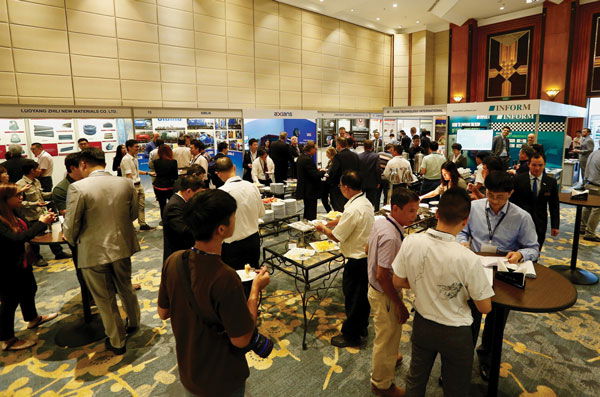
Cemtech Asia’s equipment exhibition gets underway in Hanoi
In a diversion from the technical presentations, Lucky Cement’s Noman Hasan (Pakistan) delivered an overview of Pakistan’s cement industry, which is expected to receive a further increase in demand due to an increasingly urbanised population. Over half of the country’s population will be living in cities by 2030 and therefore, over 100m citizens would require upgraded urban infrastructure. As such, production capacity in the country is set to rise to 76Mta in 2020-21.
Matthias Dietrich, Sika Services (Switzerland), examined the impact of cement additives on the production of cement. Amongst other benefits, cement additives increase production, save energy and reduce wear.
Fons Technology’s Mogens Juhl Føns (Turkey) demonstrated the benefits of having a stepped air flow function (STAFF) built into its clinker coolers, which provides a consistent flow of air despite pressure losses in the clinker layer.
SAP Asia’s Avenish Prasad (Singapore)provided an overview of digital trends in the cement industry and suggested that there are additional opportunities to gain a competitive advantage by embracing new technologies such as the Internet of Things (IoT) and Big Data.
Alberto Pedrinoni of Redecam Group (Italy) presented a series of successful case studies where the company had installed dedusting systems in the ASEAN region to reduce dust emissions to <10mg/Nm3. Elsewhere, Rogerio Lopes, Yara (Sweden), spoke about the reduction of NOx emissions through the use of selective non-catalytic reduction (SNCR) systems. Over 140 cement production lines use Yara’s SNCR system, which involves the injection of a reagent into the process and has resulted in an >80 per cent reduction in NOx.
Alan Tran, Aumund (Hong Kong), covered the company’s environmentally friendly solutions for mobile loading, unloading, road imports and storage. This included the Samson feeder solution for an intake system, which requires no excavation and reduces dust emissions compared to a traditional system.
thyssenkrupp’s Steven Yap (Singapore) analysed the benefits of investing in an efficient automated laboratory system. On an average 6000tpd kiln line, an automated system could provide an annual saving of US$4.7m. The company’s polab system covers three main areas of operation: automatic sample delivery, sample preparation and quality assurance software.
Chongren Zhong of Shanghai Conch Kawasaki (China) delivered a comprehensive look at waste heat recovery plants and solid waste disposal solutions supplied by the company. The Conch Kawasaki Kiln (CKK) system was introduced in 2010 as a waste disposal plant that combines a dry-process cement kiln with a gasification furnace to dispose of solid waste, with 26 sets (6900tpd) now installed in China.
Plant tour
As part of the Cemtech Asia programme, delegates were invited to visit the newly-commissioned line at Xuan Thanh Cement’s Ha Nam facility. Adding 12,500tpd of capacity to the plant, the line began producing clinker in October 2017. Upon arrival at the plant, delegates were welcomed by plant staff and shown the FLSmidth-supplied production line.
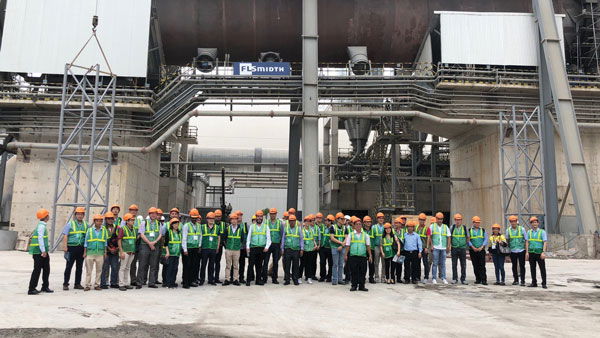
Delegates visited the newly-commissioned 12,500tpd line at Xuan Thanh Cement’s Ha Nam facility
Extended programme
Cemtech Asia 2018 featured its largest regional exhibition yet of 39 stands, giving delegates the opportunity for direct contact with a range of leading equipment suppliers.
In addition, participants attended a gala dinner featuring local entertainment to celebrate the conclusion of a successful conference and exhibition.
Next event
Cemtech Europe will be held at the Conrad Istanbul Bosphorus, Turkey, on 14-17 October 2018.
This article was first published in International Cement Review in August 2018.
